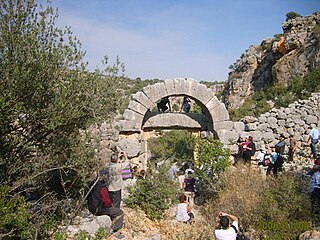Related Research Articles
Charadrus or Charadros was a town on the coast of ancient Cilicia, between Platanus and Cragus, according to the Stadiasmus. Strabo, who writes it Χαραδροῦς, describes it as a fort with a port below it, and a mountain Andriclus above it. It is described by Francis Beaufort "as an opening through the mountains with a small river." The mountain is mentioned in the Stadiasmus under the name Androcus.
Kasara was a town of ancient Caria. Its name does not appear in ancient authors but is inferred from inscriptions.
Hydas, also known as Hyda (Ὑδά), was an inland town of ancient Caria, mentioned by Pliny the Elder.
Zephyrium or Zephyrion, also called Zephyrium on the Calycadnus to differentiate it from other towns called Zephyrium, was a town of ancient Cilicia on the Calycadnus River near its mouth, on a promontory of the same name.
Diocaesarea or Diocaesareia or Diokaisareia, also called Anazarba and Kyinda was a Graeco-Roman town located in Cilicia Trachea mentioned by Ptolemy and the ecclesiastical authorities. It was in time assigned to the late Roman province of Isauria. It was a bishopric; no longer the seat a residential bishop, it remains a titular see of the Roman Catholic Church.
Aunesis was a coastal town of ancient Pamphylia or of Cilicia, inhabited during Roman times. It was the port of Hamaxia.
Augai or Augae was a coastal town of ancient Pamphylia or of Cilicia, inhabited during Roman times. It was located 70 stadia from Aunesis.
Ptolemais was a coastal town of ancient Pamphylia or of Cilicia, inhabited during Hellenistic times. It was located between the Melas River and Coracesium.
Kynosarion was a coastal town of ancient Pamphylia, inhabited during Roman times.
Pisurgia or Pisourgia was a town on the coast of ancient Cilicia, between Celenderis and Seleucia ad Calycadnum, 45 stadia to the west of Cape Crauni, and to the right of the island of Crambusa.
Pseudokorasion was a town of ancient Cilicia, on the coast a little to the east of Seleucia ad Calycadnum, inhabited during the Hellenistic, Roman and Byzantine eras.

Korasion, also called Kalon Korakesion, was a town of ancient Cilicia, on the coast a little to the east of Seleucia ad Calycadnum, inhabited during the Roman and Byzantine eras.
Arima, also called Krine, was a town of ancient Cilicia, on the coast east of Seleucia ad Calycadnum. Arima was noted in Greek Mythology in connection with Typhon and Arima, couch of Typhoeus.
Kanytelis was an inland town of ancient Cilicia, inhabited during the Hellenistic, Roman, and Byzantine eras. Its name does not appear among ancient authors but is inferred from epigraphic and other evidence.
Kalanthia was a coastal town of ancient Cilicia, inhabited during the Roman and Byzantine eras.
Balbissa was a town of ancient Cappadocia, inhabited in Byzantine times. The name Balbissa does not occur in ancient authors but is inferred from epigraphic and other evidence.
Thouththourbia was a town of ancient Cilicia, inhabited in Roman times. The name does not occur among ancient authors but is inferred from epigraphic and other evidence.
Lamatorma was a town of ancient Cilicia, inhabited in Roman times.
Gozalena was a town of ancient Pontus, inhabited during Roman times.
Pedachtoë or Pedachthoe, also known as Heracleopolis or Herakleioupolis, was a town of ancient Pontus, inhabited during Roman and Byzantine times. It was assigned to the late Roman province of Armenia Prima, in which it became the seat of an archbishop. No longer a residential see, it remains a titular see of the Roman Catholic Church.
References
- 1 2 Richard Talbert, ed. (2000). Barrington Atlas of the Greek and Roman World . Princeton University Press. p. 66, and directory notes accompanying.
- ↑ Lund University. Digital Atlas of the Roman Empire.
Coordinates: 36°27′06″N34°06′17″E / 36.4516°N 34.10485°E